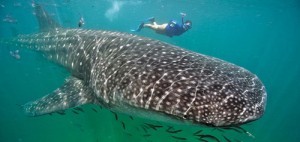This tracker, found on Matagorda Island, had been attached to a whale shark off the Yucatan Peninsula by wildlife researchers.
The day started out as a beautiful morning with the sun shining, not a gust of wind. My husband and I took our boat out to Matagorda Island with the intention of enjoying fishing and the scenery. After about an hour of catching absolutely nothing, I decided I’d go beach combing by the lighthouse on the Island. As I was walking, I started imagining all sorts of lost treasures that may have been lost at sea and washed up on the shore. Just then I looked down at the sand and saw a small, grey, rocket shaped object just laying in the sand. Upon a closer look, I realized this thing was neither a toy, or trash, but some sort of transmitter. At this point, we decided to pack up and head to the boat ramp.
Along our way home, we stopped to pick up a lost wave runner. As we stopped, a big wave hit the boat and threw my husband out. He was not hurt so we started out again. Suddenly the boat stopped; we had run out of gas and had to be rescued. When we finally got back to dry land, we called the phone number on the transmitter and left a message saying we had found it. The next Monday I got a call from the Wildlife Conservation Society located in Belize saying that the transmitter belonged on a Whale Shark that had recently been tagged. The sharks are tagged off the coast of the Yucatan Peninsula, Mexico. The sharks gather there, several hundred of whale sharks at a time, to eat fish eggs.
I am sending the transmitter back so the data can be retrieved and the transmitter can be refitted to another animal. More information about this research can be found in the September issue of the Mens Journal or the June issue of the Smithsonian Magazine. You can also go the wildlife web site: www.wildlifetracking/org
Whale Sharks
The average size of adult whale sharks is estimated at 31.82 ft. and 20,000 lb. The largest verified specimen was caught on November 11, 1947, near Baba Island, in Karachi, Pakistan. It was 41.50 ft. long, weighed more than 47,000 lbs., and had a girth of 23.0 ft. Stories exist of vastly larger specimens — quoted lengths of 59 ft. are not uncommon in the popular shark literature — but no scientific records support their existence.
As a filter feeder it has a capacious mouth which can be up to 1.5 metres (4.9 ft.) wide and can contain between 300 and 350 rows of tiny teeth. It has five large pairs of gills. Two small eyes are located towards the front of the shark’s wide, flat head. The body is mostly grey with a white belly; three prominent ridges run along each side of the animal and the skin is marked with a “checkerboard” of pale yellow spots and stripes. These spots are unique to each individual and are useful for counting populations. Its skin can be up to 3.9 inches thick.
The whale shark inhabits all tropical and warm-temperate seas. They are known to migrate every spring to the continental shelf of the central west coast of Australia. As a filter feeder, the whale shark feeds on macro-algae, plankton, krill, Christmas Island red crab larvae, and small nektonic life such as small squid or vertebrates. It also feeds on small fish. The many rows of teeth play no role in feeding; in fact, they are reduced in size in the whale shark. Instead, the shark sucks in a mouthful of water, closes its mouth and expels the water through its gills.
Despite its size, the whale shark does not pose significant danger to humans. Although massive, whale sharks are docile fish and sometimes allow swimmers to catch a ride. Whale sharks are actually quite gentle and can play with divers. Divers and snorkellers can swim with this giant fish without risk, apart from unintentional blows from the shark’s large tail fin. In July 2011, several sources reported, with photos, an incident of a diver who, allegedly, was nearly sucked into the mouth of a whale shark (but escaped unharmed) off the coast of Isla Mujeres, Mexico.
The capture of a female in July 1996 which was pregnant with 300 pups indicates that whale sharks are ovoviviparous. The eggs remain in the body and the females give birth to live young which are 40 to 60 centimeters (16 to 24 in.) long. It is believed that they reach sexual maturity at around 30 years and the life span is an estimated 70 to 100 years.
from Wikipedia
Want to Adopt a Whale?
The ECOCEAN Whale Shark Photo-identification Library is a visual database of whale shark (Rhincodon typus) encounters and of individually catalogued whale sharks. The library is maintained and used by marine biologists to collect and analyze whale shark encounter data to learn more about these amazing creatures. You can support the ongoing research of the ECOCEAN Whale Shark Photo-identification Library by adopting a whale shark: http://whaleshark.org/adoptashark.jsp
Editor’s Note: The above information should not be considered as an endorsement by Dolphin Talk. Interested readers should check out the organization for themselves.

